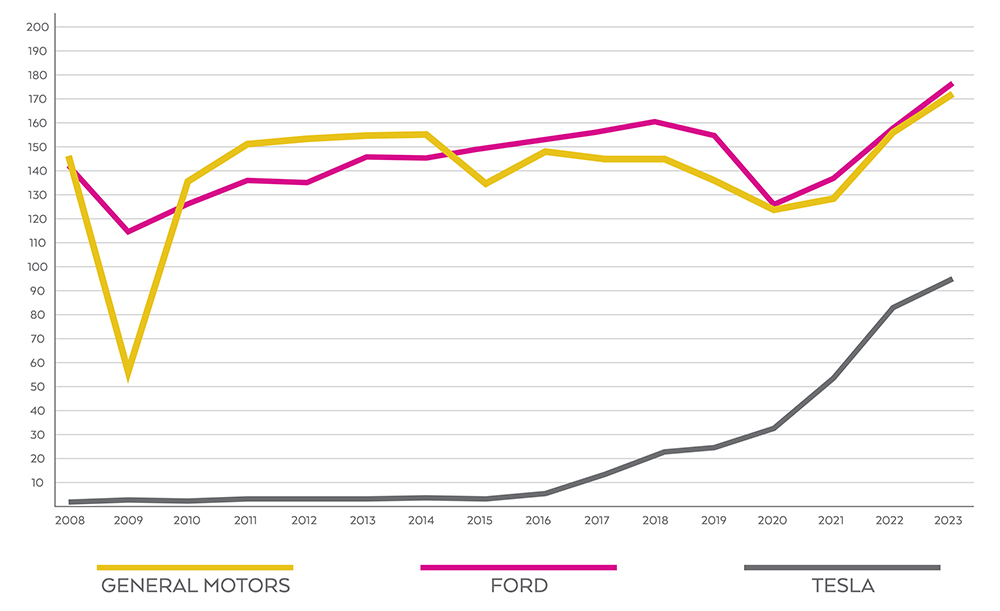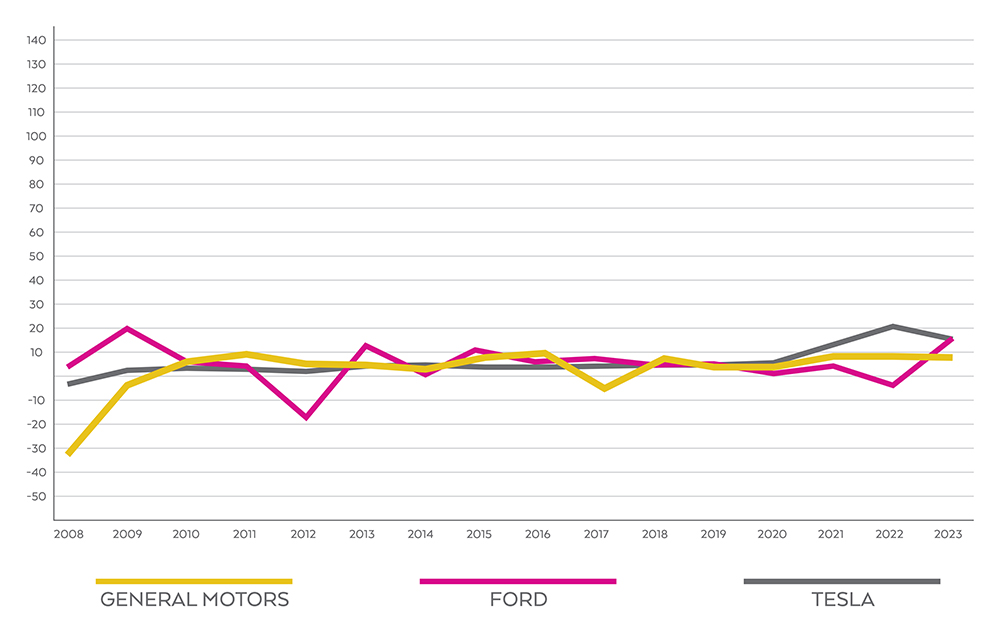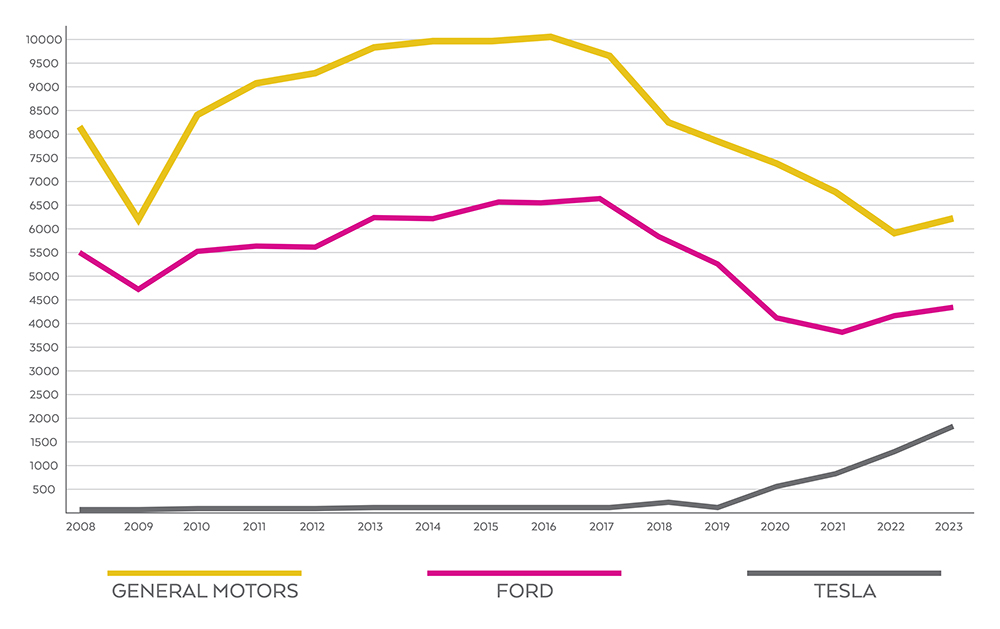TESLA'S FUTURE LOOKS LIKE THE PAST
On February 6, 2023, an investor named Charlie Bilello posted a tweet comparing the financial performance of Tesla with GM and Ford. The post compared figures from 2012 and 2022. In 2012, GM and Ford revenues exceeded $130 billion, while Tesla revenues were $413 million, less than 1% of the automotive juggernauts. By 2022, Tesla revenues had increased to 52% of GM and Ford, but more importantly, its profits had surpassed its competitors. Tesla CEO Elon Musk retweeted the post with the caption "How times have changed." Various media outlets repeated the figures with headlines like "Tesla Makes Twice as Much Money as GM and Ford Combined" and "Tesla Will Overthrow GM and Ford by 2027." The news doubled Tesla's market valuation to nearly $800 billion, 16 times more than both GM and Ford, which were valued at $49 billion. So is the hype warranted, are the analyses true, and most importantly, is the data complete?
The Ford Motor Company was founded in 1903, and General Motors in 1904. Due to innovations like the assembly line and mass production, Ford quickly became the largest automaker in the world. In 1931, GM overtook Ford, and held the title of the largest manufacturer of automobiles for 77 years. The two companies dominated the automobile industry for most of the 20th century.
In 1990, GM debuted a prototype electric car called Impact. That prototype led to the EV1, the first mass-produced electric car in the world. Between 1996 and 1999, GM produced just over 1000 EV1s, but ultimately couldn't find a cost-effective way to build the cars. GM invested over $1 billion in the EV1 program. Most experts agree the EV1 was a decade ahead of its time. Battery technology had to improve, but even today, limited range and necessary government subsidies plague the widespread adoption of electric vehicles. In 1997, GM also created the first electric pickup truck, the S-10 EV, which suffered the same fate as the EV1. But the S-10 EV spurred Ford to create its first electric vehicle, the Ranger EV, in 1998. The Ford Ranger EV was manufactured a little longer than GM's efforts until 2002.
The following year, Tesla was founded by Martin Eberhard and Marc Tarpenning. In 2004, the founders secured $6.5 million in funding from Elon Musk, who became chairman of the board. It took the company four years and an additional $180 million to produce its first car. They managed to produce 147 of its first model, the Roadster, in 2008. The following year, it received a loan of $452 million from the Department of Energy as part of the Advanced Technology Vehicle Manufacturing program. That money supported the development of Tesla's next generation vehicle, the Model S, which became its first widely successful product.
In 2009, as a result of the global economic crisis, General Motors declared bankruptcy. In order to avoid the collapse of another large American company, the federal government elected to bail out the automaker with $50 billion. The move saved the company and ultimately allowed GM to develop its next round of innovations, including more marketable electric vehicles. Ford was in a similar financial state, but managed to secure investments from sources other than the federal government.
The government managed to recoup almost $40 billion of its investment in GM, ultimately losing $11 billion. Ford emerged a stronger company with higher profit margins than General Motors. Meanwhile, in May 2013, Tesla became the only American car company to fully repay their government loan, and did so nine years earlier than expected.
So all three companies found themselves in dire financial straits in 2008. All three companies received outside funding in 2009. And all three companies eventually achieved stability and profitability. While both GM and Ford had over 100 years of selling cars, Tesla sold its first car in 2008. Comparing profits for all three companies between 2008 and 2023 does indeed demonstrate a stark contrast between the legacy manufacturers and the upstart company. And it seems even more impressive when the total units manufactured is included, revealing Tesla making an enormous profit while selling less than 30% of the vehicles than General Motors. On the surface, it appears the hype is true. But there's more data to the story.
ANNUAL REVENUE IN BILLIONS OF DOLLARS

ANNUAL PROFIT IN BILLIONS OF DOLLARS

ANNUAL PRODUCTION IN THOUSANDS OF VEHICLES

The longstanding belief that "economies of scale" eventually result in higher profit margins has recently been called into question. In a paper published in 2020, researchers examined all 6103 U.S. companies that went public since 1974. For every company, there was no significant decrease in overall costs or increase in profit margins at any stage of their growth. Ford was a private company until 1956, so actual sales and profit figures from its earlier years are unavailable. But General Motors has been a public company since 1916. In 1926, GM reached the level of production that Tesla achieved in 2022, a million vehicles for the first time. That year, GM sales were just over $1 billion, and its profits were $186 million, or 18% of its gross revenue. When Tesla reached a million cars, its sales were $81 billion and its profits were $21 billion, 25% of its gross revenue. However, last year when Tesla's vehicle production rose to almost two million units, its sales increased to $97 billion but its profits dropped to $18 billion, 18% of its gross revenue, just like GM in 1926. Based on the data, there is every reason to believe that as Tesla continues to grow, its profits will follow the same path as the other automakers. In 2023, GM's profit was 6% of its gross revenue and Ford's profit was 10% of its gross revenue.
A main reason for the disconnect between Tesla and the other automobile manufacturers is the perception and language surrounding the new company. Tesla is valued like a tech company rather than an automaker, meaning its stock value is calculated aggressively and optimistically at 21 times its earnings. Longstanding corporations GM and Ford are valued at just 5 times their earnings. Perhaps there's some merit in considering Tesla a bit of a different company than most automakers, but more than four times more valuable is probably an overestimation in the long run.
Interestingly, there are early signs that this is already the case. In 2024, with slowing electric vehicles sales, that Tesla will redefine itself as an AI and robotics company. Some analysts see this as an admission that the company cannot continue to maintain its stock value as purely a car company. Whatever its fate, it will be interesting to watch the development of the company as it continues to find its place among the existing automobile and AI firms. But the prophecies of Tesla outgrowing and even supplanting GM and Ford are wildly suspect and based on very specific and limited data. Tesla conveniently began manufacturing cars when GM and Ford were suffering some of their worst years as companies. So yes, any growth compared to their losses will look extremely impressive. And Tesla experienced massive profits compared to the other two companies in 2022, but as shown, those companies experienced those same levels of profit when they were that small and just starting out in a brand new industry. And the next year, Tesla and Ford had the same profit, which was not twice that of GM. It was a very specific, isolated year of data that sparked the hype in Tesla's stock and story. Electric cars are undoubtedly the future, and right now, Tesla looks like it is commanding that future. But the data indicates that even if Tesla wins the electric car race, it will not look like Tesla does now when it emerges. It will probably look more like GM.
SOURCES
- "The Week in Charts (2/13/23)" from Charlie Bilello
- "Tesla Makes More Money Than Ford and GM Combined" from The Street
- "Tesla Makes 5x More per Car than Toyota and Twice as Much as GM and Ford Combined" from Carscoops
- "Tesla to Overthrow Ford & GM in Revenue by 2027" from Tesmanian
- "Toyota Ahead of G.M. in 2008 Sales" from the New York Times
- "GM Could Have Led the Electric Revolution with the EV1" from BBC TopGear
- "Despite Demise, EV1 Was a Risk Worth Taking" from Automotive News
- "The S-10 EV: Chevy’s Rare Electric Pickup Truck" from Autotrader
- "The Ford Ranger EV Was Ford’s Response to the Electric Chevy S-10" from Autotrader
- "U.S. Government Says It Lost $11.2 Billion on GM Bailout" from Reuters
- "The Auto Bailout 10 Years Later: Was It the Right Call?" from the Wharton School of the University of Pennsylvania
- "Tesla Repays Department of Energy Loan Nine Years Early" from Tesla
- "In the American Grain" from Pittsburgh Quarterly
- "Contrary to Conventional Wisdom, Margins Don’t Rise as a Company Grows" from Yale Insights
- "Tesla Could Still Fall More than 60% if It's Valued as a Traditional Automaker Like Ford or General Motors" from Business Insider
- "Is Tesla Stock a Buy or a Sell with Elon Musk's Pay Package Expected to Pass by 'Wide Margins'?" from Investor's Business Daily
- Revenue, earnings, and production data from various annual reports













